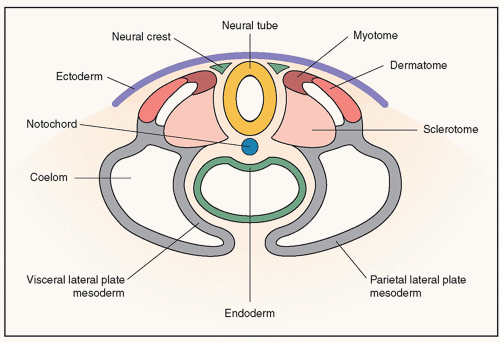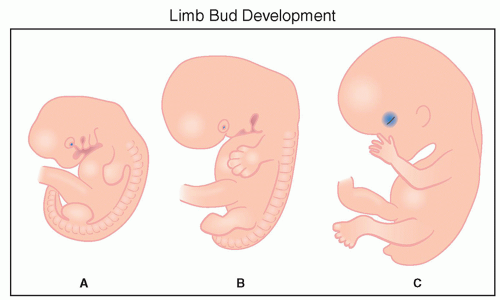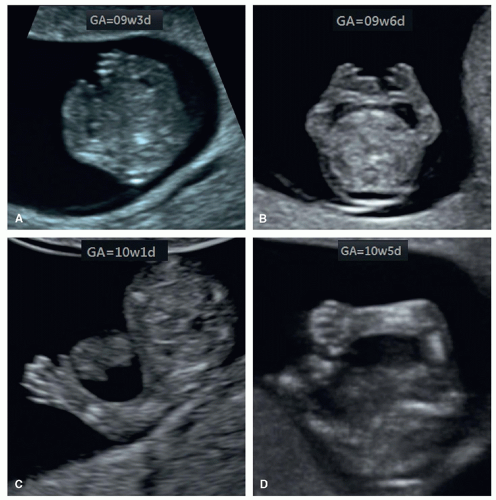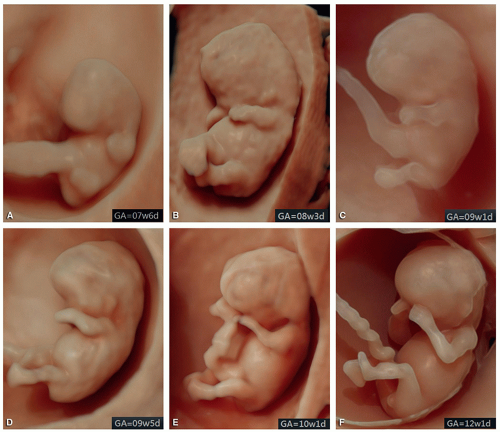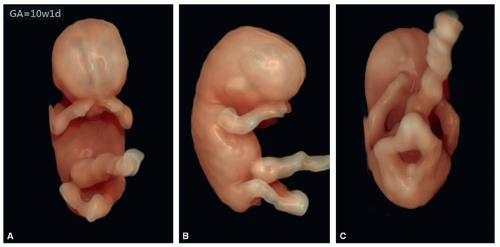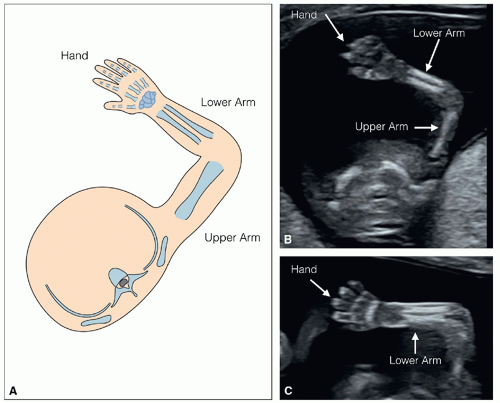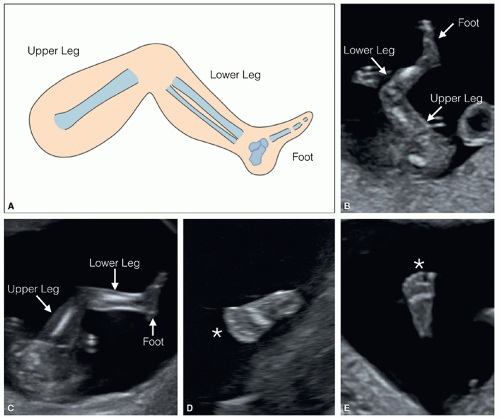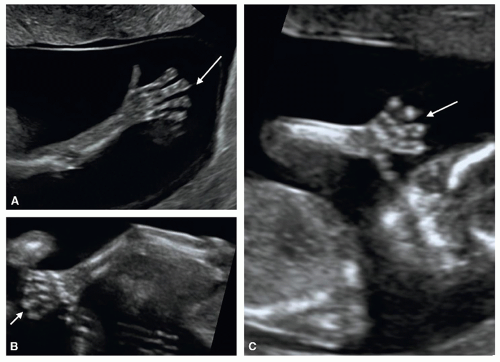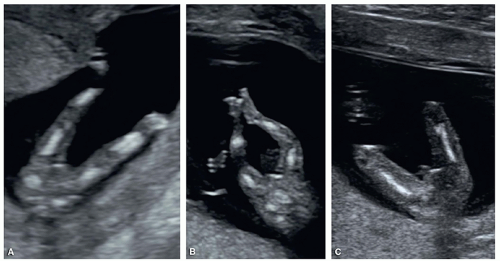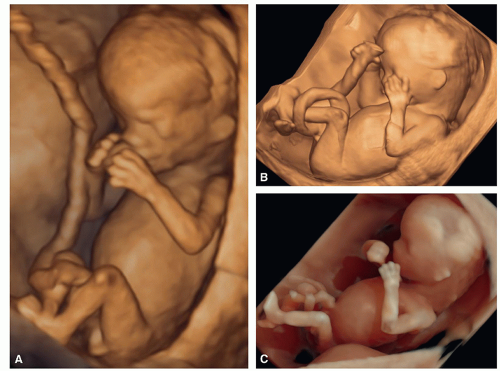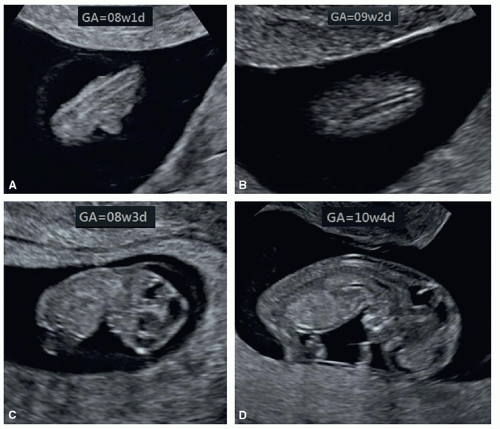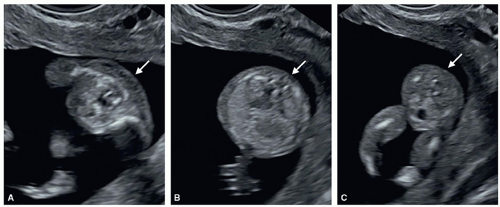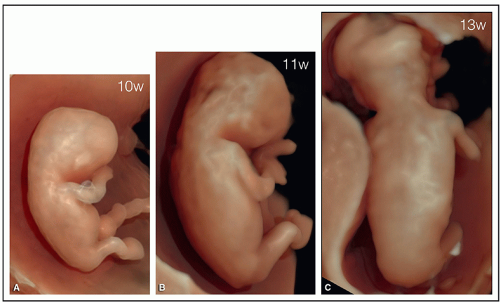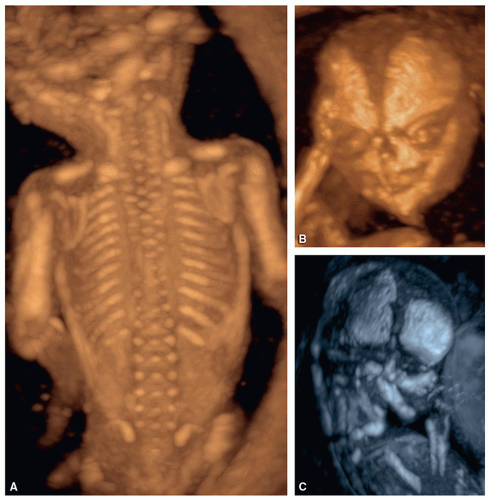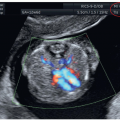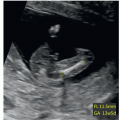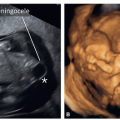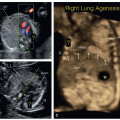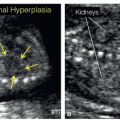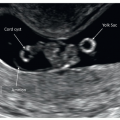The Fetal Skeletal System
INTRODUCTION
Ultrasound in the first trimester provides a distinct advantage over ultrasound in the second and third trimester of pregnancy for the evaluation of the fetal skeletal system, especially the upper and lower extremities. With advancing gestation, fetal crowding makes evaluation of the extremities and spine more challenging. Sonographic evaluation of the skeletal system in the first trimester includes imaging of the cranium, the ribs, the spine, and the four extremities. An understanding of the gestational progression of bone ossification is important in order to differentiate normal from abnormal findings. In this chapter, we present a brief description of embryology of the skeletal system, its normal sonographic examination, along with common skeletal system abnormalities that can be diagnosed in the first trimester of pregnancy.
EMBRYOLOGY
The skeletal system includes the axial and appendicular skeleton. The axial skeleton comprises the skull, spine, and rib cage, and the appendicular skeleton is made of the upper and lower extremities along with the shoulder and pelvic girdles. The skeletal system is primarily derived from the mesoderm, which appears during the third week of embryogenesis. The mesoderm gives rise to mesenchymal cells, which differentiate into fibroblasts, chondroblasts, and osteoblasts to form the tissue of the musculoskeletal system. The embryonic mesoderm is divided into three distinct regions: paraxial mesoderm (medially), intermediate mesoderm (middle part), and lateral plate mesoderm (laterally). The skeletal system is formed from the paraxial and lateral plate mesoderm, along with neural crest cells, derived from ectoderm. The paraxial mesoderm forms the axial skeleton and lateral plate mesoderm forms the appendicular skeleton.
The paraxial mesoderm segments into somites along the neural tube by the third week of embryogenesis. The somites differentiate into the sclerotome (ventromedial part) and the dermomyotome (dermatome and myotome) (dorsolateral part) (Fig. 14.1). During the fifth week of embryogenesis, the upper and lower limb buds are seen as outpocketings from the ventrolateral body wall at the spinal levels of C5-C8 and L3-L5, respectively (Fig. 14.2A). The terminal portions of limb buds flatten out in the fifth week to form hand and foot plates (Fig. 14.2B). Circular constrictions are noted between the proximal portions and the plates, representing the future wrist and ankle creases (Fig. 14.2B). During the fifth week, the upper limbs rotate 90 degrees laterally, whereas the lower limbs rotate 90 degrees medially. Growth of the limb buds continues between the fifth and the eighth week until the extremities take their definitive form (Fig. 14.2C).
Bone ossification occurs in two types: membranous and intracartilaginous. The membranous type is the process of bone formation directly from mesenchyme and is typically seen in flat bone such as the skull, whereas intracartilaginous ossification is the process of ossification from cartilaginous cells and is seen in the spine and long bones. By the end of the fourth week, the cartilaginous centers appear in the long bones, and bone ossification starts by the end of the sixth week. Bone ossification continues postnatally into the second decade of life. The muscles of developing limbs and the axial skeleton are formed from myotomes, derived from the somatic mesoderm. Retinoic acid appears to be important for the initiation of limb bud outgrowth, and appropriate differentiation of the skeletal system has been demonstrated to require sequential Hox gene expression.1,2
Abnormal development of the skeletal system results in numerous congenital anomalies such as reduction or duplication defects and skeletal dysplasia. Normal anatomy of the skeletal system on ultrasound along with skeletal anomalies that can be seen in the first trimester will be discussed in the following sections.
NORMAL SONOGRAPHIC ANATOMY
The first evidence of development of extremities includes the limb buds, which are first seen on ultrasound at around
the eighth week of gestation, with the upper limb buds seen before the lower limb buds3 (Figs. 14.3 and 14.4). Three-dimensional (3D) ultrasound in surface mode is very helpful in the identification of limb buds and four extremities in the first trimester (Figs. 14.5 and 14.6). Visualization of the normal fetal extremities in the first trimester ultrasound includes the demonstration of four limbs, each with three segments along with normal orientations of hands and feet. This is easily accomplished by obtaining a ventral view of the fetus (Fig. 14.6A and C) (see also Chapter 5). Evaluation of a
single extremity is commonly demonstrated in a longitudinal view (Figs. 14.7 and 14.8). Digits of the hands and feet are reported to be seen from the 11th week of gestation onward3; with the new high-resolution transducers however, they can be visualized from 9 weeks onward (Fig. 14.3). Imaging of the fingers may help in the identification of abnormal conditions (polydactyly) and is accomplished by using a high-resolution transducer, either transabdominally or transvaginally (Fig. 14.9). A ventral view of the feet also helps in the demonstration of terminal phalanges (Fig. 14.8D and E). By around the 10th week of gestation, ossification centers within all long bones can be demonstrated. Note that when the lower legs are extended at the knees, the whole lower extremities are seen on ultrasound obtained from the ventral aspect of the fetus (Fig. 14.10A and B). When the legs are flexed at the knees, only the upper segments (thighs) are seen (Fig. 14.10C). 3D ultrasound at 12 weeks or beyond, obtained from the ventral or lateral approach, can clearly demonstrate upper and lower extremities including both hands and feet (Fig. 14.11).
the eighth week of gestation, with the upper limb buds seen before the lower limb buds3 (Figs. 14.3 and 14.4). Three-dimensional (3D) ultrasound in surface mode is very helpful in the identification of limb buds and four extremities in the first trimester (Figs. 14.5 and 14.6). Visualization of the normal fetal extremities in the first trimester ultrasound includes the demonstration of four limbs, each with three segments along with normal orientations of hands and feet. This is easily accomplished by obtaining a ventral view of the fetus (Fig. 14.6A and C) (see also Chapter 5). Evaluation of a
single extremity is commonly demonstrated in a longitudinal view (Figs. 14.7 and 14.8). Digits of the hands and feet are reported to be seen from the 11th week of gestation onward3; with the new high-resolution transducers however, they can be visualized from 9 weeks onward (Fig. 14.3). Imaging of the fingers may help in the identification of abnormal conditions (polydactyly) and is accomplished by using a high-resolution transducer, either transabdominally or transvaginally (Fig. 14.9). A ventral view of the feet also helps in the demonstration of terminal phalanges (Fig. 14.8D and E). By around the 10th week of gestation, ossification centers within all long bones can be demonstrated. Note that when the lower legs are extended at the knees, the whole lower extremities are seen on ultrasound obtained from the ventral aspect of the fetus (Fig. 14.10A and B). When the legs are flexed at the knees, only the upper segments (thighs) are seen (Fig. 14.10C). 3D ultrasound at 12 weeks or beyond, obtained from the ventral or lateral approach, can clearly demonstrate upper and lower extremities including both hands and feet (Fig. 14.11).
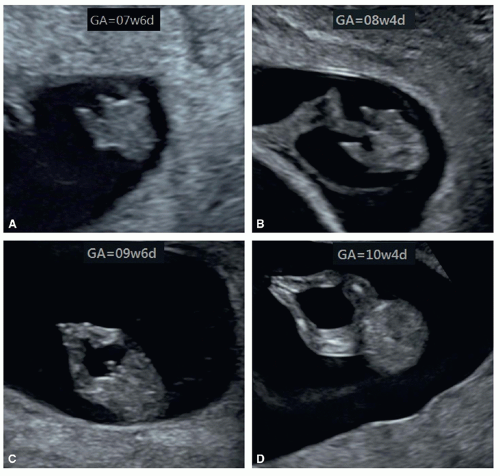 Figure 14.4: Development of legs and feet between 7 and 10 weeks (A-D) of gestation visualized on two-dimensional gray-scale ultrasound. Note that between the 7th and the 8th week (A and B), the legs are straight and short, and by the 9th and 10th week, the feet are in close proximity and touch each other. Before 10 weeks of gestation, the most optimum approach to image the lower extremities is a view inferior to the pelvis (looking from below). Three-dimensional ultrasound is also very helpful in early gestation to assess upper and lower extremities. See Figures 14.5 and 14.6 for more detail. |
The fetal spine is difficult to image before the 11th week of gestation because of lack of bone ossification (Fig. 14.12). At 12 weeks of gestation and beyond, the spine is imaged on ultrasound with such details to allow for diagnosis of major spinal deformities (Fig. 14.13). In the first trimester, the fetal spine can be evaluated in the sagittal (Figs. 14.13 and 5.22) and coronal views (Fig. 5.23), but also where possible in
axial views at the cervical, thoracic, and lumbosacral regions (Fig. 14.14). This approach is important when spinal abnormalities are suspected such as spina bifida. When technically feasible, 3D ultrasound in surface mode allows for an excellent evaluation of the integrity of the fetal back and spine for open spina bifida in the first trimester (Figs. 14.15, 8.45, and 8.47). Furthermore, 3D ultrasound in skeletal mode of a coronal view of the fetus allows for the evaluation of the spine and thoracic cavity (Fig. 14.16A). 3D ultrasound in skeletal mode also allows for an evaluation of facial and cranial bones
in the first trimester (Fig. 14.16B and C). Imaging of the fetal cranium has been discussed in Chapter 8.
axial views at the cervical, thoracic, and lumbosacral regions (Fig. 14.14). This approach is important when spinal abnormalities are suspected such as spina bifida. When technically feasible, 3D ultrasound in surface mode allows for an excellent evaluation of the integrity of the fetal back and spine for open spina bifida in the first trimester (Figs. 14.15, 8.45, and 8.47). Furthermore, 3D ultrasound in skeletal mode of a coronal view of the fetus allows for the evaluation of the spine and thoracic cavity (Fig. 14.16A). 3D ultrasound in skeletal mode also allows for an evaluation of facial and cranial bones
in the first trimester (Fig. 14.16B and C). Imaging of the fetal cranium has been discussed in Chapter 8.
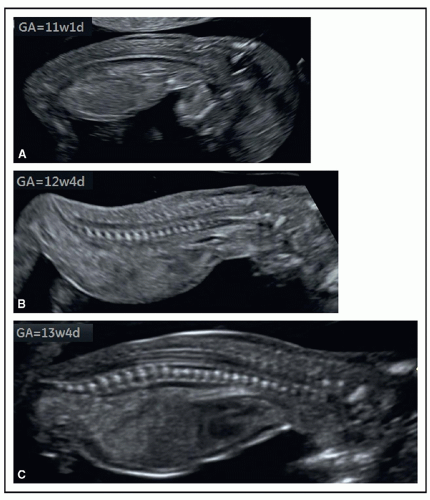 Figure 14.13: Midline sagittal planes of the fetal spine in two-dimensional ultrasound in three fetuses at 11 (A), 12 (B), and 13 (C) weeks of gestation. Note the progressive ossification of the spine between 11 (A) and 13 (C) weeks of gestation. Compare the spine ossification with Figure 14.12. |
SKELETAL SYSTEM ABNORMALITIES
When compared to the second and third trimester of pregnancy, fewer abnormalities of the skeletal system can be diagnosed in the first trimester primarily because of delayed ossification of bone. In general, the more severe the skeletal abnormality, the more evident it is on ultrasound in the first trimester. Furthermore, confirming the exact type of skeletal abnormality can be challenging in the first trimester. There are two major types of skeletal abnormalities: generalized and localized. Generalized skeletal abnormalities refer to skeletal dysplasia(s), and localized abnormalities refer to more focal malformations of spine and limbs.
Skeletal Dysplasias
Definition
Skeletal dysplasias are a large mixed group of bone and cartilage abnormalities resulting in abnormal growth, shape, and/or density of the skeleton. The birth prevalence of skeletal dysplasias ranges from 2 to 7 per 10,000 births.4 The first trimester diagnosis of a case of skeletal dysplasia (thanatophoric dwarfism) was originally performed in 1988,5 and since then, several cases have been diagnosed by ultrasound in the first trimester6, 7, 8, 9, 10, 11, 12, 13, 14 (Table 14.1). When technically feasible, the first trimester diagnosis of skeletal dysplasia is helpful because it allows for fetal karyotyping and for molecular genetic testing. Molecular genetic testing takes time, and thus, its performance in the first trimester allows for the results to be available in the second trimester for appropriate patient counseling. Mutation in the FGFR3 gene is responsible for a spectrum of skeletal dysplasias to include thanatophoric dysplasia on one end and
achondroplasia and hypochondroplasia on the other end.15 When a lethal skeletal dysplasia is suspected in the first trimester, a follow-up ultrasound examination is recommended at around 15 to 17 weeks of gestation, because detailed sonographic features of the malformation are commonly present by then. It is important to note, however, that the typical sonographic features of many significant skeletal dysplasias are present by about the 14th week of gestation, and thus, suspecting its presence is possible in most cases. Suspicion for and/or detection of skeletal dysplasia in the first trimester has been reported in up to 80% in some series,16 with lethal abnormalities having the highest detection rates. Accurate diagnosis of the specific subtype of skeletal dysplasia is often difficult in the absence of a relevant family history.14 Enlarged nuchal translucency (NT) and/or hydrops is commonly seen in fetuses with skeletal dysplasias in the first trimester.14,16,17 There is considerable phenotypic overlap between various types of skeletal dysplasia, and the specific diagnosis may be difficult to make in the first trimester.
achondroplasia and hypochondroplasia on the other end.15 When a lethal skeletal dysplasia is suspected in the first trimester, a follow-up ultrasound examination is recommended at around 15 to 17 weeks of gestation, because detailed sonographic features of the malformation are commonly present by then. It is important to note, however, that the typical sonographic features of many significant skeletal dysplasias are present by about the 14th week of gestation, and thus, suspecting its presence is possible in most cases. Suspicion for and/or detection of skeletal dysplasia in the first trimester has been reported in up to 80% in some series,16 with lethal abnormalities having the highest detection rates. Accurate diagnosis of the specific subtype of skeletal dysplasia is often difficult in the absence of a relevant family history.14 Enlarged nuchal translucency (NT) and/or hydrops is commonly seen in fetuses with skeletal dysplasias in the first trimester.14,16,17 There is considerable phenotypic overlap between various types of skeletal dysplasia, and the specific diagnosis may be difficult to make in the first trimester.
Table 14.1 • Skeletal Dysplasias That Can Be Diagnosed by 14 Weeks of Gestation | ||||||||||||
|---|---|---|---|---|---|---|---|---|---|---|---|---|
|
Stay updated, free articles. Join our Telegram channel

Full access? Get Clinical Tree



